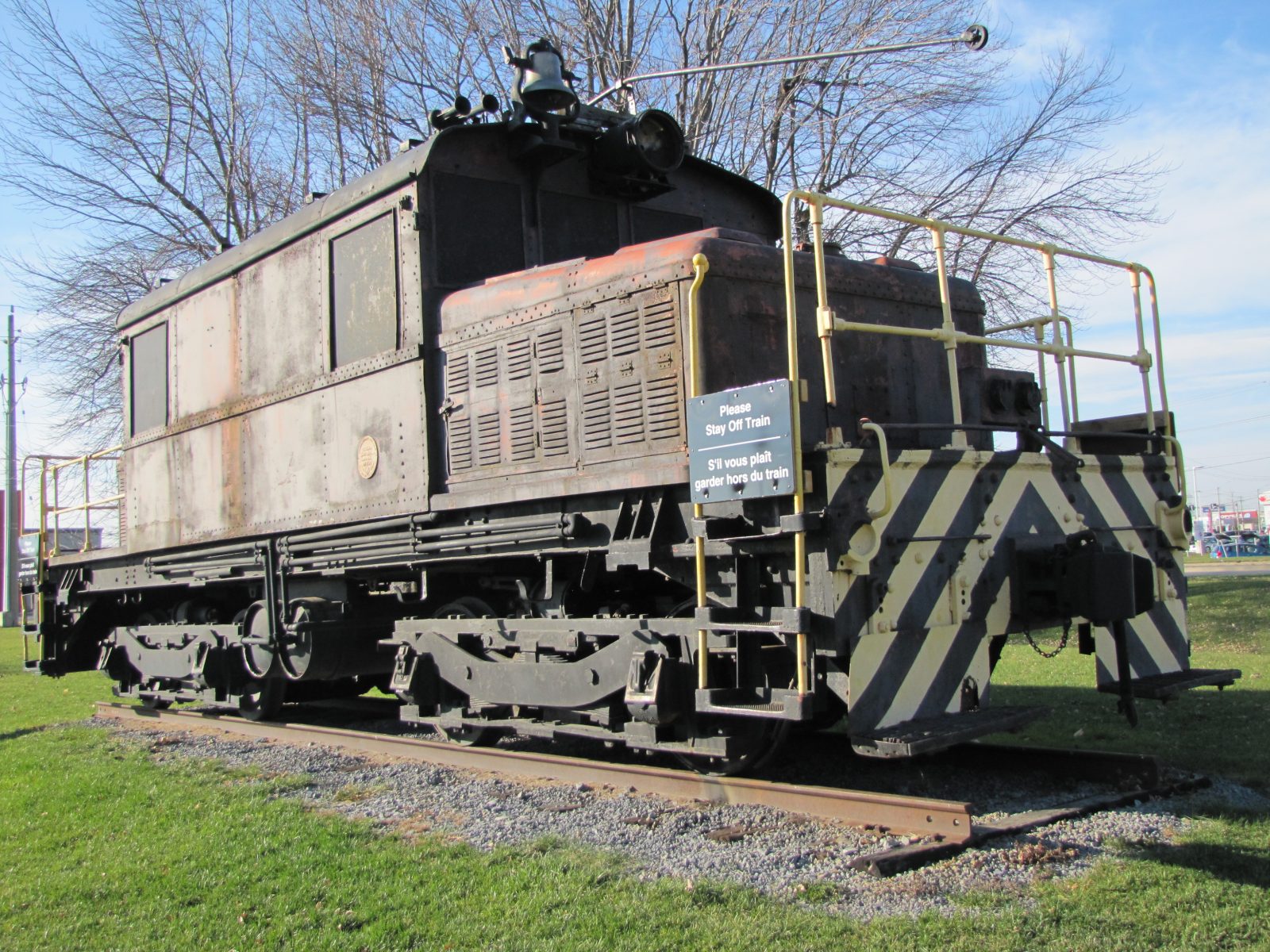Engine 17: Why it matters
Cornwall owes its success, in no small way, to the Cornwall Street Railway Company (CSR). For 134 years, economic growth depended on CSR and its successors. The legacy of CSR today includes the preferential electricity rates from Quebec and the Progress Fund from the sale of Cornwall Electric for $67,000,000. The only tangible remnant remaining is Engine 17—and that it is why it is a meaningful symbol of our history.
Economic activity always accrues to the terminus of a canal. The commencement of the Cornwall Canal in 1834 was a major influence in the commercial and industrial growth of Cornwall. Our City can be justly described as the cradle of industrialization to the west. The canal provided water for three cotton mills; The Stormont and Canada Mills as well as the Canadian Cotton Mill. This was further enhanced with the expansion of the canal including a
dry dock, the wall of which is still visible from Harbour Road.
Dr. Darby Bergin, M.P. and first Surgeon General of Canada, made significant contributions to labour and industrial health. Motivated by conditions in the Cornwall textile industry, he introduced a series of private member bills between 1879 and 1886 to regulate the employment of children and women in factories. Today, he is recognized annually at the site of a plaque erected to commemorate his many contributions, at the central pier of the swing bridge over the Cornwall Canal at the foot of Augustus Street.
Edison’s Light in Canada Cornwall, Ontario, April 4—A very successful exhibition of Edison’s electric light was given here to-day at the Dominion Cotton Manufacturing Company’s mills. Special trains were run from Ottawa and Montreal, bringing about 350 persons, including ministers, members of Parliament, and other notables from Ottawa, and the principal commercial men and others from Montreal. Mr. Edison, accompanied by a party from New York was also here. —New York Times, New York City, 5 Apr 1883.
Many came to Cornwall and the Canada Cotton Company to tour the first electrified industrial plant in Canada. But the crowds of local citizens outnumbered visitors as they gathered to watch as the lights were turned on. Electricity had reached Cornwall!
Parliamentarians were so impressed by this innovative display of new technology that Mr. Edison was hired to bring his invention to the Parliament. It was unveiled during the official visit of the Duke of York in 1901 when Parliament lights were first lit as an entertainment for the Duke.
At that time, Cornwall was well known as a vanguard of innovations and a leader in technical advancement in its industry. Our leaders were forward thinkers, electricity was green and a replacement for coal.
It was the availability of electricity that led to the founding of CSR in 1887. Its vision, much advanced for its time, was an electric railway for both passenger and freight on the same track following existing streets and roads. It was unique in that it was not just a streetcar railway nor just a steam engine spur line. CSR delivered raw materials and collected finished products efficiently with its links to the three railroad interchanges servicing Cornwall. It benefitted not only the factories but also the community as a whole making movement of people easier and affordable, in an era when only few people had cars. It was developed by the business leaders with a sense of betterment for the community. On Saturday nights in the summer, the streetcars also took citizens to St. Lawrence Park, across from Courtaulds, and the hugely popular dance pavilion there!
By 1902 CSR became Cornwall Street Railway, Light and Power Company branding itself as Cornwall Electric in 1972. Like many municipalities in Ontario, Cornwall was tempted in 1912 to join the new provincial publicly-owned Ontario Hydro. However, residents were un-swayed. The result being many years of preferential electricity rates compared to most of Ontario.
In Cornwall during WWII, the then-secret mustard gas plant on Wallrich Avenue led to the final extension of the system’s lines. The track plan had tentacles into every industry and into places where no steam engine could ever go because of the sharp corners and narrow streets.
Many of us have followed a boxcar along Water Street or William Street. The company made the decision to end streetcar service permanently in 1949 and switch to electric trolleybus service continuing its clean energy initiative. Recognizing the importance of Cornwall’s electrical rail system, a group of rail enthusiasts came together and formed Canada’s first operating trolley museum in Cornwall called the Cornwall Electric Railway Society (a precursor to today’s railway museums that offer street car rides). They operated from 1949 to 1952 using the last remaining CSR street cars. They also had permission to use various freight motors, running them on scheduled weekends, over the street railway system of the city.
In 1994, Cornwall Electric, concerned about its energy dependence on just one supplier, constructed the first municipally-owned hot water district heating and cogeneration system in Canada. By 1970, Cornwall’s loss to the Seaway and the “advantages” of trucks and diesel buses brought an end to the railway. In 1977, the City acquired Cornwall Electric, only to sell it in 1998 for $67,000,000. After paying off the city’s debt with the sale, the city of Cornwall created the Progress Fund with the remaining proceeds. Over the years the Fund has been used to help with the redevelopment of the hospital, establish the hospice, build the aquatic centre, and is currently paying off the mortgage on the Benson Centre with the interest it generates.
Cornwall was an industrial and innovation beacon in the late 1880s. People, inventors and investors travelled from far and wide to visit Cornwall. Cornwall was the cradle of technology in Canada. Yet we basically have nothing remaining of that era. All factories have been demolished or transformed into condominiums and stores. The visual past has almost been erased from memory.
However, an interactive display with Engine 17 at its centre will rekindle curiosity, improve and preserve the knowledge of our industrial and innovative past. Cornwall’s contribution was not just government, church, and education.
The Team Cornwall publication of 1977 reported, “The history of Cornwall Electric, that began with Thomas Edison…the growth over the years and the masterful decisions…has created a situation few communities large or small have had the good fortune to experience.”
All that’s left is Engine 17. That’s why it is important. That’s why it’s our history. And that’s why it needs to be saved.
Engine 17: What happened
Electric freight service continued until 1971, shortly after the company’s freight operations were purchased by CN Rail. As the last operating electric motor locomotive in Canada, CN donated Engine 17 to the City in remembrance of the CSR operations. Citizens of Cornwall donated to the refurbishing including $20,000 from the Kinsmen of Club of Cornwall. In August of 1981, Engine 17 was placed in front of the Cornwall Water Filtration Plant on Second Street West.
Suffering from vandalism, Engine 17 it was moved to the south-east corner of Brookdale and Ninth, adjacent to a forgotten CSR track. Soil conditions in Lamoureux Park were considered unsatisfactory. Heritage-Patrimoine Cornwall (HPC) recommended historic designation for Engine 17 which the city approved in 2006 (By-law #31-2006). HPC allocated funds for yearly maintenance and in 2013 requested $50,000 to stabilize the engine. The City set aside $30,000 in its reserve fund. In 2014 HPC did background work on the cost of removing lead paint,
advised the city in its 2015 budget detail that the project was beyond the scope or mandate of HPC.
With $100,000 in reserve, the Administration has prepared detailed information for repairing the exterior shell. Knowing the weight at 75 tons, it can be assumed that 50 tons will be the transformers and electric motors which are not needed for display purposes and can be salvaged.
At today’s prices this is worth upwards of $20,000. Administration research includes the removal of lead-free paint in accordance with Ministry of Environment standards. With the advice of railroad museums, it has been determined that “railroad quality paint” will provide long-lasting protection from the elements. No more “Good Samaritan” paint jobs involving house paint!
Engine 17 became an orphan in the City’s administrative structure. Its condition worsened every year. It became an embarrassment to the citizens; more so by those who recognized its significance. At the same time Councillors forgot that the citizens had already contributed to Engine 17 and it was an affront to ask again—having neglected Engine 17 for so long. City Council, embarrassed by its condition and perhaps because of their neglect, removed the $100,000 from reserve at budget time and agreed to pay to have it disappear. Repeal of the designation by-law requires the City to seek the advice of HPC, serve notice of intent to Ontario Heritage Trust publish in the newspaper, receive objections for 30 days, refer objections to the Conservation Review Board (CRB), the appeal body relative to designation (Ontario Heritage Act Section 31), considers CRB’s report and then Council decides.
To save Engine 17, Council must vote against the repeal of the historic designation.
Engine 17: Where is home
Engine 17 worked in and for this City and the community. Engine 17 and its Green innovative electric railway system was a cornerstone in a complex network that made Cornwall industries thrive and brought its population work. Sent to another city, its symbolism will be lost and dwarfed by big steam locomotives. Engine 17 has provenance here. It needs to be where it can be seen, appreciated and secured to avoid any more abuse. The relocation of Engine 17 in its
lighter, refurbished version with original bright colours needs to be located and displayed in the proper heritage place that it deserves. But most importantly the CSR story, Cornwall’s economic story, needs to be told and it cannot
be contained on a plaque. It is not only about a decision to preserve a machine or a piece of metal, but it is about preserving what it truly represents and means to Cornwall and its history. It is one of the only visual reminders of that proud past and we must make it tell its story.
Donating it at a cost of $50,000 to a train museum is an option that will only celebrate an engine and erase Cornwall’s proud innovative and industrial past. It has no voice but the SD&G Historical Society is prepared to design a plan in collaboration with other stakeholders to make it the centrepiece for commemorating Cornwall’s innovative past. It needs to be in a place where visitors and citizens gather and may have time to learn about our history.
Our City needs to pick up the pieces and locate Engine 17 as the focal point to highlight ourindustrial history. That place is the Benson Centre. The Benson Centre should be selected because it is the busiest location in Cornwall attracting over 100,000 people every year. It is a place where all age groups meet. Local and regional figure skating, hockey, soccer and lacrosse tournaments are hosted at that location attracting young athletes, parents, grandparents and families from Québec, Ontario and upstate New-York. The Benson Centre is also a gathering location for local and area seniors and adults with a wide range of activities from walking, pickle ball, yoga, Tai Chi, badminton, tennis to ballroom dancing, little chefs cooking and social clubs. It is used by corporate businesses, groups, individuals, non-profit groups for AGM’s, team meetings, art and leisure classes, small fitness groups, workshops, seminars, presentations, family gatherings, birthday parties and more.
Numerous young athletic organizations practice there also such as football, lacrosse and soccer during their off season. Security and hosting staff are always present, constantly patrolling the site. The Benson Centre is the perfect location to set-up a “Cornwall: Industrial and Innovation Past” interactive centre. There is a lot of down time for parents and families between games and while the children are practising. An interactive display will offer them a new place to go and learn about Cornwall.
Engine 17 worked in the Domtar yard. It is time to bring it home!



